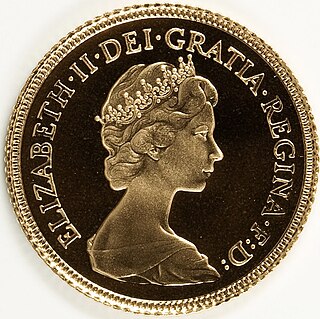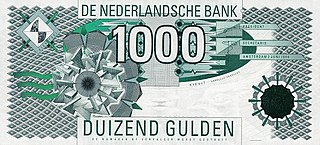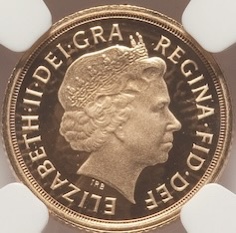
The British florin, or two-shilling piece, was a coin worth 1⁄10 of one pound, or 24 pence. It was issued from 1849 until 1967, with a final issue for collectors dated 1970. It was the last coin circulating immediately prior to decimalisation to be demonetised, in 1993, having for a quarter of a century circulated alongside the ten-pence piece, identical in specifications and value.

The British threepence piece, usually simply known as a threepence, thruppence, or thruppenny bit, was a denomination of sterling coinage worth 1⁄80 of one pound or 1⁄4 of one shilling. It was used in the United Kingdom, and earlier in Great Britain and England. Similar denominations were later used throughout the British Empire and Commonwealth countries, notably in Australia, New Zealand and South Africa.

The half sovereign is a British gold coin denominated at one-half of a pound sterling. First issued in its present form in 1817, it has been struck by the Royal Mint in most years since 1980 as a collector's and bullion piece.

The ducat coin was used as a trade coin in Europe from the later Middle Ages to the 19th century. Its most familiar version, the gold ducat or sequin containing around 3.5 grams of 98.6% fine gold, originated in Venice in 1284 and gained wide international acceptance over the centuries. Similarly named silver ducatons also existed. The gold ducat circulated along with the Florentine florin and preceded both the modern British pound sterling and the United States dollar.

The guilder or florin was the currency of the Netherlands from 1434 until 2002, when it was replaced by the euro.
The coins of the South African pound were part of the physical form of South Africa's historical currency, the South African pound. Prior to the Union of 1910, various authorities issued their own pounds, some as independent entities. After the Union but before 1923, coins in circulation were mostly British, but the coins of Paul Kruger's South African Republic remained in circulation. In 1923, South Africa began to issue its own coins, adopting coins that were identical in size and value to those used in Great Britain: 12 pence (12d) = 1 shilling (1s), and 20s = 1 pound (£1). On 14 February 1961, the Union of South Africa adopted a decimal currency, replacing the pound with the Rand.

The Netherlands Indies guilder was the unit of account of the Dutch East Indies from 1602 under the United East India Company, following Dutch practice first adopted in the 15th century. A variety of Dutch, Spanish and Asian coins were in official and common usage. After the collapse of the VOC at the end of the 18th century, control of the islands reverted to the Dutch government, which issued silver 'Netherlands Indies' guilder and fractional silver and copper coins until Indonesian independence in 1945.
The coins of Canada are produced by the Royal Canadian Mint and denominated in Canadian dollars ($) and the subunit of dollars, cents (¢). An effigy of the reigning monarch always appears on the obverse of all coins. There are standard images which appear on the reverse, but there are also commemorative and numismatic issues with different images on the reverse.

Christopher Ironside OBE, FRBS was an English painter and coin designer, particularly known for the reverse sides of the new British coins issued on decimalisation in 1971.

The Dutch Five guilder coin was the highest-denomination coin in the Netherlands from its introduction in 1988 until the adoption of the euro in 2002. Its nominal value was ƒ 5,-.

The Dutch 1 guilder coin struck under the reign of Queen Wilhelmina was a unit of currency in the Netherlands.
The One guilder coin was a coin struck in the Kingdom of the Netherlands between 1818 and 2001. It remained in circulation until 2002 when the guilder currency was replaced by the euro. No guilder coins were minted in the German occupation of the Netherlands in World War II.

The shilling, informally called a "bob", was a type of silver coinage issued by the Commonwealth of Australia, that circulated prior to the decimalisation of Australian coinage. The Australian shilling was derived from the British pre-decimal sterling pound system and was first issued following the passing of the Australian Coinage Act 1909, which established Australia's first formal currency system. The shilling was issued as part of Australia's silver coinage, which included the two-shilling (florin), the sixpence and the threepence. The shilling was minted from 1910 until 1963. During this period there was one significant modification to the design of the Australian shilling, the change in its reverse design, which occurred in 1938 when the design was altered from the Australian coat of arms (1910–1936) to the visage of a Merino ram's head (1938–1963).

The first coins of the Indonesian rupiah were issued in 1951 and 1952, a year or so later than the first Indonesian rupiah banknotes printed, following the peace treaty with the Netherlands in November 1949. Although revolutionary currency had been issued by the provisional Indonesian government between 1945 and 1949, it had all been formed of paper, for metal were too scarce for the internationally isolated government to use as currency.

The quarter sovereign is a British gold bullion and collector's coin, issued by the Royal Mint since 2009. The smallest in the sovereign range, it has a face value of 25 pence.
The one leu coin was a coin of the Romanian leu. Introduced in 1870, it last circulated between 1992 and de facto 1996, when it was the lowest-denomination coin in the country. It was considered as circulating coin for accounting reasons and was still minted in proof sets until the 2005 denomination of the currency.

Johann Georg Holtzhey, was an 18th-century Dutch medallist and mint master.
The Half guilder coin was a silver coin struck in the Kingdom of the Netherlands between 1818 and 1930. The obverse featured a portrait of the Dutch reigning King or Queen. On the reverse was a crowned Dutch coat of arms between the value. All coins were minted in Utrecht except the year 1829 and 1830 that were minted in Brussels.
The Three guilder coin was a silver coin struck in the Kingdom of the Netherlands between 1817 and 1832.

The double sovereign is a gold coin of the United Kingdom with a nominal value of two pounds sterling (£2). Rarely issued in the first century and a half after its debut in 1820, it never had a significant presence in circulation. It is now a collector and bullion coin, and has been struck most years since 1980. It features the reigning monarch on its obverse and, most often, Benedetto Pistrucci's depiction of Saint George and the Dragon on the reverse.















